Table of Contents
Evaporation:
Evaporation is the process by which water gets converted from liquid to vapor. Evaporation occurs below the boiling point of the liquid.
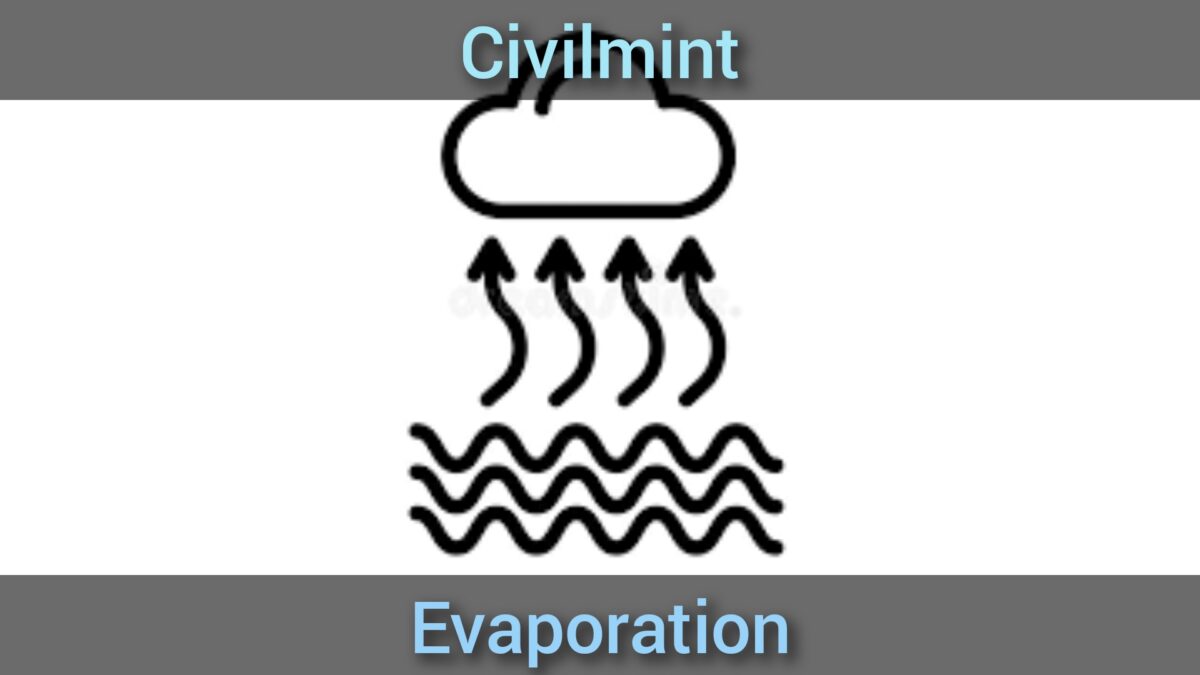
In an enclosed environment, a liquid will evaporate till the surrounding air gets saturated.
The rate of Evaporation depends on various factors as follows.
- Vapour pressures
- Wind speed
- Atmospheric pressure
- Air and water temperatures
- Size of the water body
- Concentration of substance
Estimation Methods Of Evaporation:
Evaporation can be measured by 3 methods. I’ll describe each method step by step.
1. Using Evaporimeters
These are pans containing water that has direct exposure to the environment. Water losses can be measured easily from these pans at regular intervals. Metrological data like humidity, wind velocity, air, water, temperature, and precipitation can be measured and noted along with evaporation.
I have described different types of Pan as follows.
(I) The standard United States Weather Bureau (USWB) Class A Evaporation Pan:
USWB Class A Evaporation Pan has a diameter of 1207 mm and a depth of 254 mm. water depth in the Pan is maintained between 18 and 20cm. The PAN is made of unpainted GI sheets. The PAN is placed on a wooden platform of height 15 cm and above ground level to permit free airflow below. Evaporation is measured by measuring the depth of water in a stilling well with a hook gauge.
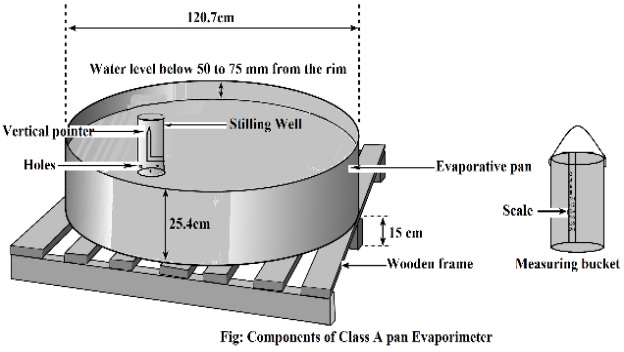
(II) ISI Standard Pan:
ISI Standard Pan is Specified by IS:5973, it is a modified version of Class A Pan. ISI Standard Pan has a diameter of 1220 mm and a depth of 255 mm. This type of Pan is made of copper sheet 0.9mm thick, tinned inside, and painted white outside. The pan is placed on a square wooden platform of a width of 1225 mm and height 100 mm above ground level to allow free air circulation below the pan.
A fixed point gauge indicates the level of water water is added to or removed from the pan to maintain the water level at a fixed mark using a calibrated cylindrical measure
The top of the pan is covered with a hexagonal wire net of GI to protect water in the pan from bird presence of the water wire-mesh making the temperature of water more uniform during the day and night. Evaporation from this pan is about 14% lower as compared to that from an unscreened pan
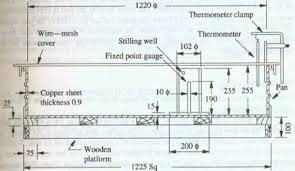
(III) Colorado Sunken Pan:
Colorado Sunken Pan is 92cm square. It is made of an unpainted GI sheet, 46cm deep, and buried into the ground within 10cm of the top. The primary advantage of this PAN – its aerodynamic and radiation characteristics are similar to that of a lake. The drawback of Colorado Sunken Pan is difficult to detect leaks, is expensive to install, extra care is needed to keep the surrounding area free from tall grass, dust, etc.
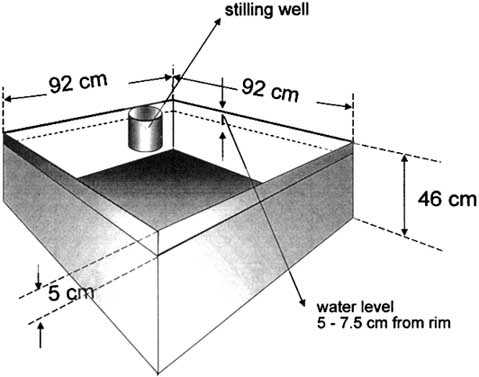
(IV) USGS Floating Pan:
USGS Floating Pan is a square pan of 90cm sides and 45cm deep. Supported by drum floats in the middle of a raft size 4.25 * 4.87 m, it is set afloat in a lake with a view to simulate the characteristic of a large body of water
The water level in the USGS Floating Pan is maintained at the same level as that in the lake leaving a rim of 7.5cm. Diagonal baffles are provided in the pan to decrease surging in the pan because of wave action
Drawback – The higher cost of installation and maintenance, difficulty in making measurement
Pan Coefficient:
Evaporation Pan is not the same model of large reservoirs. Their major drawbacks are the following:
They differ from reservoirs in the heat storage capacity and heat transfer characteristics from the sides and the bottom. Thus evaporation from a Pan depends to some extent on its size.
Thus Evaporation measured from a Pan has to be corrected to get the evaporation from a large lake under identical climatic and exposure conditions
Lake Evaporation = Pan Coefficient ( Cp ) * Pan Evaporation
Values of Pan Coefficeint Cp
| Sr No | Types Of Pan | Avg Value | Range |
| 1 | Class A Land Pan | 0.70 | 0.60-0.80 |
| 2 | ISI Pan | 0.80 | 0.65-1.10 |
| 3 | Colorado Sunken Pan | 0.78 | 0.75-0.86 |
| 4 | USGS Floating Pan | 0.80 | 0.70-0.82 |
Evaporation Pans are normally located at stations where other hydro metrological data are collected.
Evaporation Stations:
As per WMO recommendations the following values of minimum density of Evaporimeters
- Arid Zones – 1 station for every 30000 m2
- Humid Temperate Zones – 1 station for every 50000 m2
- Cold Regions – 1 station for every 100000 m2
A typical hydro-meteorological station has the following
- Recording rain gauge and non-recording rain gauge.
- Stevenson box with maximum, minimum, wet, and dry bulb thermometers
- Wind anemometer and wind vane
- Pan evaporimeter
- Sunshine Recorder etc
(2) Empirical Equations:
Most of the available empirical equations for estimating lake evaporation are a Dalton type equation of the general form
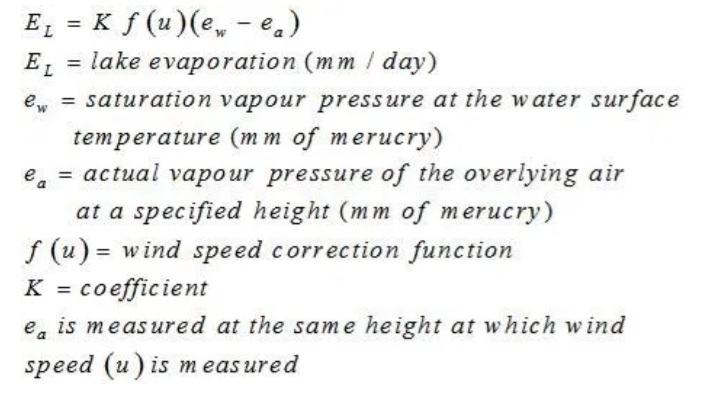
(I) Meyer’s Formula:
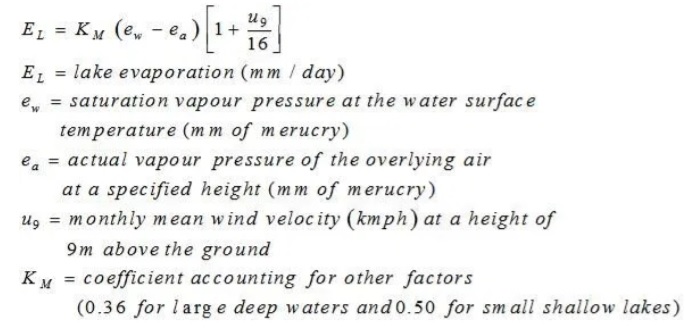
(II) Rowers’ Formula:
Accounts for the effect of pressure in addition to the wind speed effect

Wind Velocity
In the lower part of the atmosphere up to a height of about 500m above the ground level, wind velocity follows the one-seventh power law as

(3) Analytical Methods:
(I) Water Budget Method
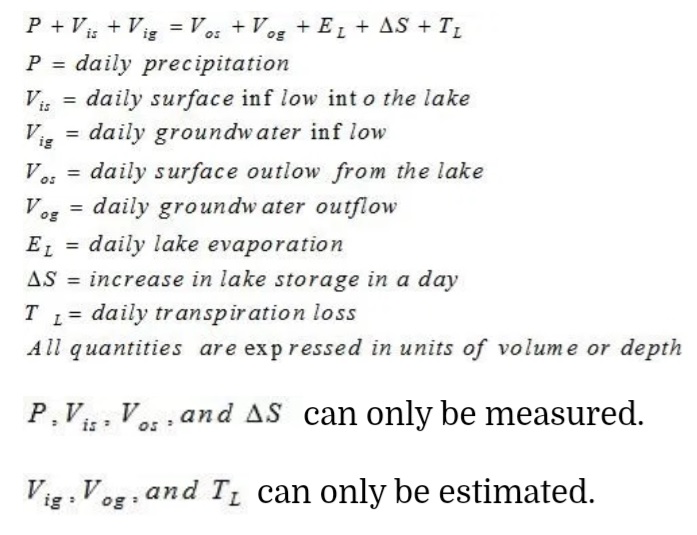
If the unit of time is kept very large, estimates of evaporation will be more accurate. It is the simplest of all the methods, but the least reliable.
(II) Energy Budget Method
- It involves application of the law of conservation of energy
- Energy available for evaporation is determined by considering the incoming energy, outgoing energy, and energy stored in the water body over a known time interval.
- Estimation of evaporation from a lake by this method has been found to give satisfactory results, with errors of the order 5 % when applied to periods less than one week.


This is the energy balance in a period of 1 day. All energy terms are in calories/sq.mm/day.
If the time periods are short Hs and Hi can be neglected as they are too small.
All terms except Ha can either be measured or evaluated indirectly.
Ha is estimated using Bowen ratio,
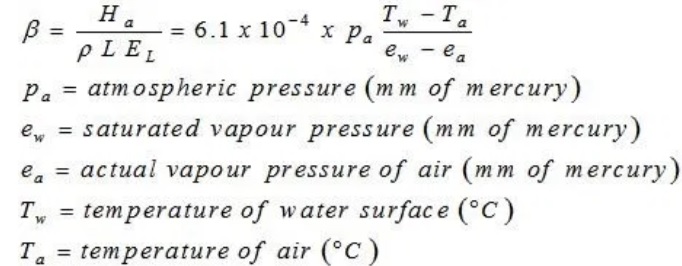
Comparison of Methods:
- Analytical methods can provide good results. But they involved parameters that are difficult to assess
- Empirical equations can at best give approximate values of the correct order of magnitudes
- In view of the above, Pan estimation finds wide acceptance in practice.
